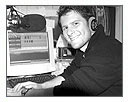|
Before finding his calling as a radio producer, Gregory Warner worked as an adjunct professor of mystical philosophy in Ukraine, a house pianist in an East Hampton piano bar, an investigator of police brutality for the city of New York, and a prison activist. He graduated from the Salt Institute for Documentary Studies and currently hosts a daily news show at North Country Public Radio. His radio documentaries have aired on NPR's All Things Considered, This American Life, Studio 360, and other public radio programs. POV In your work, you consider the notion of 'borders' of understanding between countries. What is a border to you? What borders did you encounter while working on your piece? Early on in the process of researching this piece, I was in a bookshop in Montreal and picked up an issue of Granta devoted to American identity. As I stepped up to the register and sorted through the colorful currency, I thought — Is this a little weird? To be buying a British magazine in a Canadian bookshop to learn about America.... But that was my experience doing this piece. Almost none of my own American identity really came into play. The America that I encountered overseas was simpler, more iconic. There was a World War I propagandist (George Creel) who said "America is the least known and best known country on earth." That's quite something to be a part of. POV: What is possible when innovative approaches to narrative and interactivity are combined? How is your piece different from traditional storytelling? As far as I know, this kind of web-based audio slideshow is a pretty new animal. It's not quite film, it's certainly not radio. In a way it's kind of like a graphic novel — the way stories and words combine with still pictures. Of course it's different from a graphic novel because you get to play with music, too, and instead of just still pictures you have film clips and photographs and graphic collages. So there's a lot of freedom there. At the same time it's still a kind of a lo-fi mode of storytelling. It's something that all the new software is making very easy. So it feels very democratic. POV: What, if anything, was exciting or challenging about those differences? As a radio producer, I deal exclusively in sound, so bringing visuals into the mix was terribly frightening. And then the fact is that there really aren't that many models for this format. As I said before, there are related arts but the slideshow has its own unique aspects. So that's fun but also scary. POV: Expand our borders. What's a book, movie, piece of music, website, etc. that challenges or engages with the idea of "borders" that we should know about but perhaps don't? I was surprised to realize how much amazing historical stuff is on the web. Old movies and radio broadcasts and ads and it's all under public domain. A great place to start is www.archive.org. It's where we got that wild 50s propaganda movie (Who Are The Americans). And all the music I used in the piece was on www.opsound.org, a Creative Commons site for independent artists. POV: What are you working on next? Where can we see more of your work? I host a daily news show for North Country Public Radio, in northern New York (right on the Canadian border!). I also do radio features for All Things Considered and other public radio shows like Studio 360 and This American Life. You can see my website, www.waterstonestudios.com, for links. |
